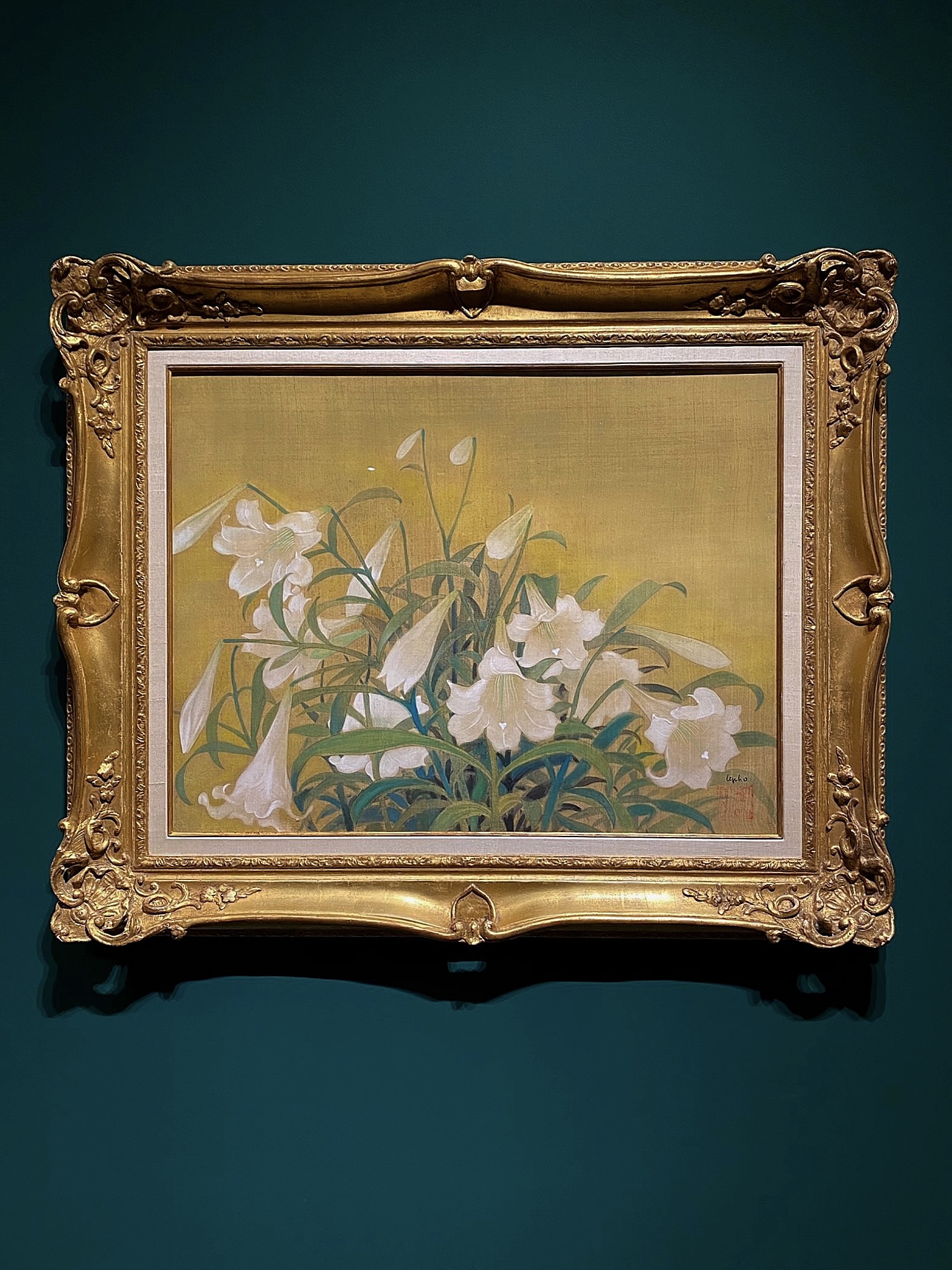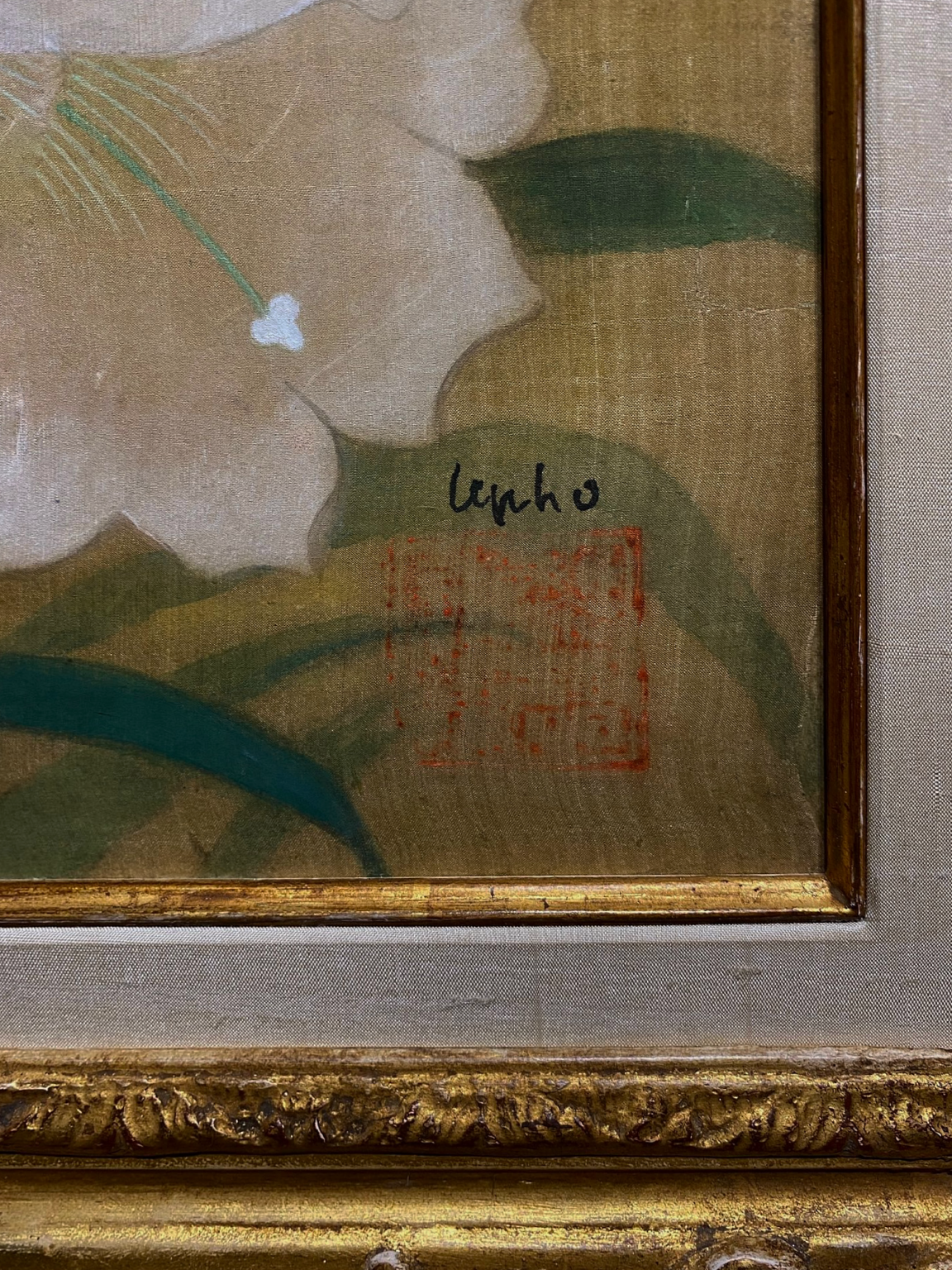
Le Pho (1907-2001)
Bouquet de lys (Bouquet of Lilies)
signed 'Le pho' (lower right)
ink and gouache on silk laid on board
55 × 72.5 cm. (21 5/8 x 28 1/2 in.)
Painted circa 1936
one seal of the artist
The most beautiful bouquet of lilies flowers painted by Le Pho (Vietnamese, 1907-2001) through the medium of gouache and ink on silk of large dimensions 56,5 x 74 cm. (22 ¹/₄ x 29 ⁹/₆₄ in.) which may be dated circa 1936. Considered as a painting of a close departure for a journey without the return of Le Pho, his subtle revolt and magnificent observation, it is the painting lives longer than the flowers it represents.
This unlike most of the groups of flowers represented by the artist will be present at the upcoming Christie’s Hong Kong Autumn Evening Auction Sale of 20th/21st Century Art, 30 November 2022. This will also be showcased at the Hong Kong Convention and Exhibition Center prior to the official sale from 26 November 2022.
Price Realised HKD 2,772,000 at Christie's Hong Kong, 30 November 2022

Le Pho's signature on his painting Bouquet de Lys (Bouquet of Lilies)
LE PHO "BOUQUET DE LYS " OR ART, "RENUNCIATION OF THE INTELLIGENCE TO REASON THE CONCRETE"
Bouquet de Lys, subject to inventory, is the most beautiful ’bouquet‘ of flowers painted by Le Pho, who was prolix in this subject matter, repeatedly depicted later in his Romanet and Findlay periods. The word ‘bouquet‘ is used with quotation marks, explained further below.
Details of Bouquet de Lys (Bouquet of Lilies) by Le Pho (Vietnamese, 1907-2001)
The painter’s subtle genius illuminates this gouache and ink on silk of large dimensions (56.5 x 74 cm) which can be dated around 1936. This is corroborated by the background left partially natural — the painter lays a discreet halo of ochre pigment around the group of flowers — the use of a large stamp although smaller than the ones used in the early 1930s — and the pastel tone of the pigments in the gouache. Rarely does the artist sign without the two Chinese characters of his name. The black ink remains discreet, in strokes, not in masses.
Here, unlike most of the groups of flowers represented by the artist, there is no pot or vase. Le Pho offers us these unattached, almost aerial lilies.
He does not depict typical flowers of his native Tonkin (Northern Vietnam): neither roses, nor chrysanthemums, nor jasmine, nor violets, nor sunflowers, peonies, gladioli or lotus. For this work, he chooses the lilies with its majestic white petals, brilliant and diaphanous at the same time.
Eight blooming flowers and eight buds are a suggestive reference to auspicious symbols: the 8 Treasures (Babao), the 8 Trigrams (Bagua), the 8 Buddhist Emblems (Bajixiang), the 8 Taoist Immortals (Baxian), amongst others. Sixteen flowers, or two times eight. Two is an even number, like eight and sixteen. It is the Yin, the symbol of the earth. Thus, it is the power of a work for attentive observers where the symbolism comes to enlighten the meaning of the subject...
The black stems center the work, and strengthen the composition, allowing the flowers - and incidentally the leaves - described with exceptional grace, to be aerial. Shades of green and a discreet turquoise blue come to assist the black in an affirmed verticality. Beauty is born from the unreal, from this deliberate opposition between an almost-botanical observation and unreal colours applied in washes.
A bouquet, in its vase, with its flowers cut and arranged by man, is a metaphor for order fought against Nature, seized in its force. But also progressively amputated from it.
Flowers in a pot, are Nature contested, roots bruised, flowers dependent on the care of their observer.
Le Pho here offers us free flowers which rest only on their roots. Roots – the painter’s supreme deep internal questioning during a time when he feels that his life will continue far away.
He refuses the ordering by human action and chooses instead the order of nature: no cut flowers in a vase destined to die quickly, no flowers in a pot destined to live weary of themselves. The marvelous eternity of Nature triumphs over the mortal man. And that is why the ‘bouquet’ is no bouquet at all.
Le Pho travelled to China in 1934. His trip modified his relationship so ambiguous in Vietnam – to that country, tinted with intellectual admiration and historical mistrust. China remains so present in Le Pho who even traced his family ancestry to Yan Li-Ben (600-673), better known as Baron Wenzhen de Boling. For the anecdote, his friends Vu Cao Dam and Mai Thu used to make fun of him on this subject calling him with an affectionate smile, ‘the baron’.
During his stay in Beijing, he understands that Chinese art will not feed his inspiration. He remained seduced by Paris and its hectic artistic life that he had discovered in 1931-32. He had just been appointed Artistic Director of the Indochina section of the Paris World's Exhibition (officially the International Exhibition of Arts and Techniques Applied to Modern Life) to be held in 1937. He felt a need for emancipation from this traditional Vietnamese Confucian society which offered nothing in terms of artistic value. His teaching position at the Hanoi Fine Arts School did not satisfy him. A powerful will to confront his art with that of all the great artists of the time who work in Paris, animates him.
Art is not a profession but a calling.
Bouquet de lys is the painting announcing an imminent departure for a journey without return. Intuitively, Le Pho knows that he will not return to Vietnam. Like his contemporary the French writer Albert Camus - who would write a little later - he understands that "The work of art is born from the intelligence’s renunciation to reason the concrete" (The Myth of Sisyphus, 1942).
The concrete is not be confused with the material. The concrete, around the year 1936, encompasses the notions of Fatherland, career, family, and friendship. Le Pho, who was not yet 30 years old, has renounced ever since his first paintings to reason the concrete. A powerful energy drives him. Le Pho knows that one exceeds the absurdity of his destiny by his lucidity, and "the tenacious revolt" against his condition. The absurdity of a destiny certainly. But there is greatness in living and making the absurd alive.
Bouquet de Lys is the painting of this subtle revolt, of this magnificent observation that a painting lives longer than the flowers it depicts.
Jean-François Hubert
Senior Expert, Vietnamese Art










